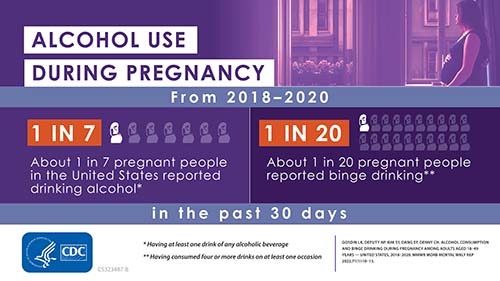Alcohol Use and Binge Drinking Among Pregnant People in the United States
Nearly 14% (or 1 in 7) pregnant people* reported current drinking and about 5% (or 1 in 20) reported binge drinking in the past 30 days, according to a new Morbidity and Mortality Weekly Report (MMWR).
Alcohol use during pregnancy continues to be a serious problem. Alcohol use during pregnancy can cause birth defects and developmental disabilities known as fetal alcohol spectrum disorders (FASDs) and might increase the risk for miscarriage and stillbirth. Screening for alcohol use combined with brief counseling by primary care providers, integration of mental health services, improved access to care, and community-based interventions might reduce alcohol use during pregnancy and the risk for poor pregnancy and birth outcomes.
Read the full scientific article.
Main Findings

In a new MMWR article, CDC researchers found
- Nearly 1 in 7 pregnant people reported current drinking, meaning at least one drink of any alcoholic beverage in the past 30 days.
- About 1 in 20 pregnant people reported binge drinking, meaning four or more drinks on one occasion at least once in the past 30 days.
- Pregnant people 25–34 years were less likely to report current drinking than those aged 35–49 years. College educated, employed, and unmarried pregnant people were more likely to report current drinking.
- A new finding in this report is that pregnant people who experienced frequent mental distress (14 or more days of poor mental health in the past 30 days) and those who did not have a usual healthcare provider were more likely to report alcohol use.
- Overall, these prevalence estimates are consistent with slightly increasing trends in current and binge drinking observed in the same survey since 2011. However, alcohol use among pregnant people was not higher in 2020 than in 2019, despite some evidence of increased alcohol sales and consumption among the general public during the COVID-19 pandemic.
*People who reported their sex at birth as female were asked if they were currently pregnant.
About this Study
- The study uses self-reported data collected from the Behavioral Risk Factor Surveillance System (BRFSS), a state-based, landline and cellphone survey of U.S. adults aged 18 years and over.
- To estimate current drinking and binge drinking for pregnant people aged 18–49 years, data from the 2018–2020 BRFSS were analyzed for all 50 states† and the District of Columbia.
†New Jersey did not collect enough data to meet the minimum requirements for inclusion in the 2019 BRFSS public use dataset.

Are you pregnant or might be pregnant?
-There is no known safe amount, no safe time, and no safe type of alcohol use in pregnancy.
-If you need help for substance use, talk with a healthcare provider.
-Visit SAMHSA’s Treatment Locator or NIAAA’s Alcohol Treatment Navigator to find local resources.

Are you a healthcare provider?
-Universal alcohol screening and brief intervention is recommended in primary and obstetric care settings.
-Use these resources for applying screening and brief intervention in your practice.
Our Work
CDC addresses alcohol and other substance use during pregnancy and FASDs. Example activities include:
- Understanding alcohol use during pregnancy: CDC estimates how much and how often pregnant people report alcohol use and binge drinking as well as use multiple substances. These data are important to help reduce prenatal alcohol use by identifying groups at increased risk and designing prevention programs to reduce risk behaviors.
- Promoting evidence-based care: CDC and partners support the implementation, adoption, and promotion of evidence-based interventions to reduce alcohol use during pregnancy, including alcohol screening and brief counseling. We are also working together to promote effective treatments for children, adolescents, and young adults living with FASDs and their families. Early identification and management of FASDs can help children and families living with FASDs receive the care and services they need to thrive.
- Providing training and resources: CDC enhances healthcare provider education, including free online training courses on preventing prenatal alcohol use and identifying and caring for people with FASDs. We are also offering FASD-related educational information and materials as well as disseminating guidelines on alcohol use, including the Dietary Guidelines for Americans.
- Disseminating accurate, up-to-date information: CDC educates and informs the general public and policymakers about effective strategies for reducing excessive alcohol use, such as those recommended by the Community Preventive Services Task Force (e.g., limiting alcohol sales).
More Information
- CDC: Fetal Alcohol Spectrum Disorders
- CDC: Alcohol and Public Health
- CDC: Alcohol Use During Pregnancy
- CDC: Fetal Alcohol Spectrum Disorders Training and Resources
- CDC: Alcohol screening and Brief Intervention Efforts
- CDC: NCBDDD Activities, Substance Use in Pregnancy
- FASD United (formerly NOFAS)
- March of Dimes: Beyond Labels, Substance Use Disorder and Pregnancy
Scientific Reference
Gosdin LK, Deputy NP, Kim SY, Dang EP, Denny CH. Alcohol consumption and binge drinking during pregnancy among adults aged 18–49 years – United States, 2018–2020. MMWR Morbidity and Mortality Weekly Report 2022;71(1): 10-13. [Read Article]